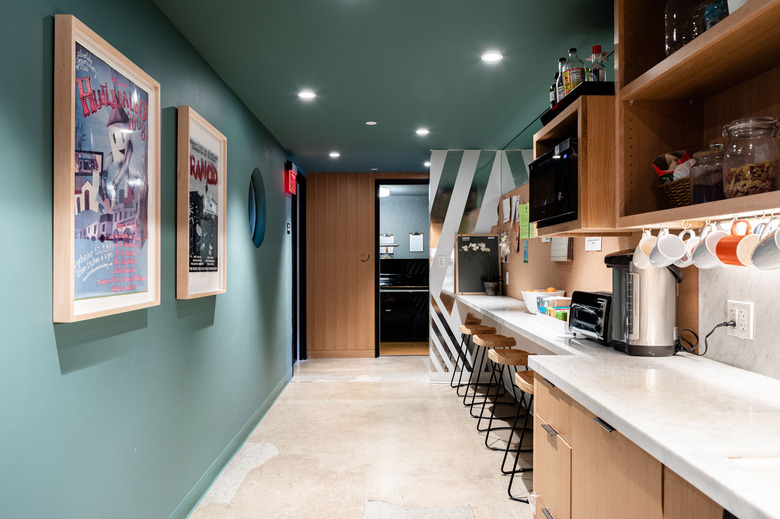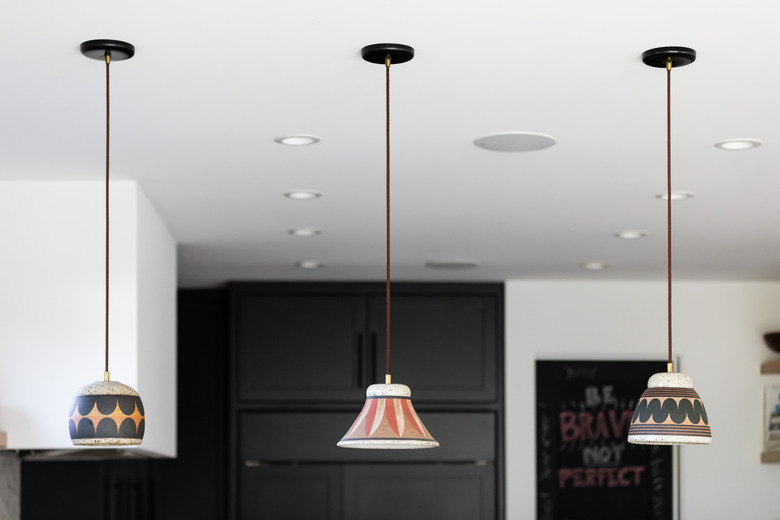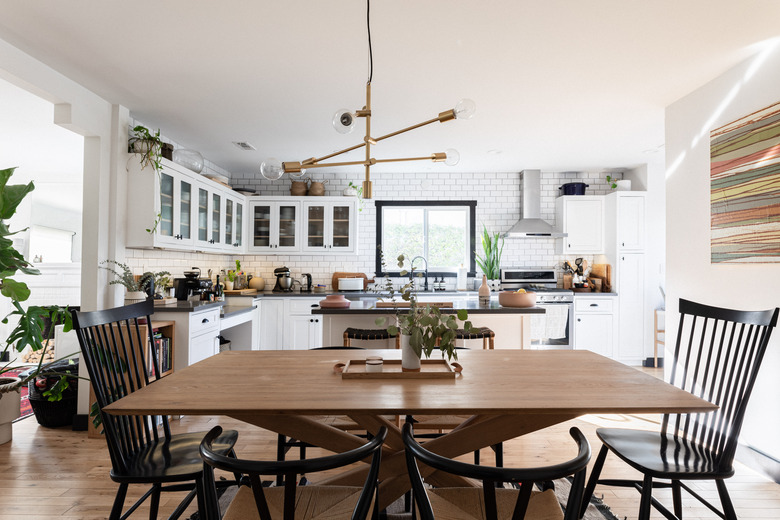8 Tips For Kitchen Lighting Design
When you are headed outside on a crisp fall day, you likely dress in layers so that you are prepared for any change in temperature. Kitchen lighting design utilizes layers as well. You will begin with basic overhead lighting that blankets the room and then add additional layers of light to help you perform specific tasks or to highlight certain areas of the room. Proper lighting is both visually appealing and functional, so make sure you plan your lighting as thoroughly as you did the rest of your kitchen remodel.
1. Choose Ambient Kitchen Lighting First
1. Choose Ambient Kitchen Lighting First
When you walk into your kitchen on a bright, sunny day, you will notice that the sun brightens the overall space. This is ambient lighting: It doesn't shine on anything specific but instead adds a glow to the entire room. Ambient lighting is the first layer of light in your kitchen, and it is typically installed on the ceiling.
You can create ambient lighting with recessed lighting, flush-mount ceiling fixtures or even a fancy chandelier if it suits you. According to the Journal of Light Construction, chandeliers and pendant lights are particularly useful in kitchens where the ceiling is 10 feet tall or higher. This is because they hang lower than other light fixtures and bring the light down into the room.
When laying out ambient lighting, plan to place a light fixture over your kitchen island if you have one, or in the center of the room if you don't. If you are using recessed lights, space them half the distance of your ceiling apart in a grid pattern around the room. When the kitchen has a 10-foot ceiling, for instance, space the recessed lights 5 feet apart. Space them 4 feet apart if you have an 8-foot ceiling.
2. Make Considerations for Task Lighting
2. Make Considerations for Task Lighting
Because ambient lighting so often comes from the center of the room, you may find that you cast a shadow over your work surface when standing at your sink or countertop. Task lighting fixes this problem by shining a light directly on your work area.
One of the most popular and functional ways to add task lighting is to install under-cabinet lights. Under-cabinet lights shine directly down on your countertop so you can easily see to read recipes, chop vegetables and perform other kitchen tasks. Installing puck, rope lights or LED strips beneath the cabinets are excellent ways to illuminate counter space. You can also mount wall sconces in your workspace if you prefer.
If your kitchen has an island, make sure your kitchen lighting design sheds some task lighting on it. This is often achieved through pendant lights, which hang straight down from the ceiling and shine a light directly on the island's surface. Pendant lights come in a wide variety of styles and can double as ambient lighting. Suspension lights also look great above an island, function well in that position and come in a wide variety of designs and colors.
3. Put Finishing Touches with Accent Lighting
3. Put Finishing Touches with Accent Lighting
Whether you do the work yourself or live through a professional job that renders your kitchen useless for a few days or weeks, kitchen remodels aren't for the faint of heart. When the work is finished, accent lighting helps you show off the work you have done and creates a cozy feel. Accent lighting is often provided via track lighting, which allows you to shine a light directly onto a favorite piece of art or an intricate backsplash design you had installed over your stove.
You can also install mini spotlights, LED lights or puck lights inside a glass-front kitchen cabinet to highlight special china or glasses. If you love your crown molding, install a rope light on top of your kitchen cabinets shining up to the ceiling to show it off. You can also add toe-kick lighting, which is usually provided by LED strips.
4. Consider Adding Dimmers
4. Consider Adding Dimmers
Ambient lighting mimics natural light, and turning it on should be as easy as flipping a switch. A standard on-and-off switch doesn't always work with task or accent lighting, however. These light sources prove most useful when installed on a dimmer switch.
A dimmer allows you much more control over the mood your kitchen lighting creates and adds versatility. You can, for example, turn up the brightness on under-cabinet lights when using them as task lighting and turn them down to create a more intimate feel or to use them as night lights. Having accent and task lights on a separate switch from your ambient light is also more energy efficient. If it is just you having dinner, do you really need to turn on the cabinet lights and show off your crystal collection?
It is also better to hard-wire your lighting fixtures, wherever they may be in your kitchen. Rope lights and LED strips often come with batteries, but you will find yourself constantly changing them if you use them often. It is far more convenient to have your electrician hard-wire them for you when it is practical to do so. Many accent and task fixtures are also available with cords and on-board switches so you can simply plug them into a nearby outlet.
5. Choosing the Right Color
5. Choosing the Right Color
Not all lights and light bulbs are the same. Some emit a warm yellow glow, while others shine so white they almost look blue. The best color for your kitchen lighting fixtures depends in part on your personal taste and in part on the purpose of the light. The color temperature of light is measured in kelvins, which will tell you what kind of light a particular bulb produces.
The lower the kelvin measurement, the warmer and more yellowish the light produced by the bulb. A bulb with a higher rating will be a cooler blue and will shine a bit brighter. The scale breaks down as such:
- 2,000 to 3,000 K: soft white, yellowish hue
- 3,100 to 4,500 K: cool, bright white
- 4,600 to 6,500 K: daylight
Choose a cool, bright, white bulb in ambient and task-lighting fixtures to illuminate floors and work surfaces with a neutral light. Accent lighting, however, looks best when it features bulbs that produce softer light. The exception to this is subtle or muted details that you want to make pop. When highlighting subtleties, choose a bright bulb that mimics daylight.
6. Think of Any Kids in the House
6. Think of Any Kids in the House
If you have small children in your home, there are a few extras about which to think when considering your kitchen lighting design. As a general rule, pendant and suspension lights hung over a kitchen island or dining table should fall 30 to 36 inches above the work surface, according to Lumens. This may, however, be too tall for children and could cause them to get a glare from the light.
This glare can make it difficult for children to help out in the kitchen or sit at the table or breakfast bar to do homework or work on craft projects. To solve this problem, hang your lights in such a way that the light bulb is about 6 feet above the child's head.
Clearly, you don't want to purchase new kitchen lighting every time your little one has a growth spurt, so plan accordingly when choosing your fixtures. Choose light designs that cover the bottom of the light bulb to diffuse the light and reduce glare or opt for a pendant light or chandelier for which you can alter the height.
7. Remember to Go Natural
7. Remember to Go Natural
Nothing is as beautiful as a room bathed in the natural light of the sun, and all that beauty is yours to enjoy for free. Take advantage of this when planning your kitchen lighting. To make sure you don't need to turn on your kitchen lights during the day, consider adding a window or two.
When big windows are not practical, consider the merits of installing a porthole window or a row of small, horizontal windows above your kitchen cabinets. If there is an outside door in your kitchen, consider installing a glass window pane in it to allow more natural light to come into the room.
8. Some General Kitchen Lighting Rules
8. Some General Kitchen Lighting Rules
When designing the kitchen lighting plan for your kitchen, keep a few tips in mind. The first is to always remember your layers. Homeowners often get so focused on ambient lighting that they try to make one light source do it all, with disastrous results. Reserve a little something special for yourself in your lighting plans too. You and your guests will see most of your lights when in your kitchen, but it is smart to tuck a few away.
If your kitchen has a pantry, for instance, consider hanging a motion-activated light there that comes on when you open the door. It doesn't have to be pretty, just useful. You can install similar lights inside your cabinets and drawers. These lights won't add any beauty to your kitchen, but they will add function.
Remember that while design and style are important, functionality and practicality should rule the day. If hard-wiring a light fixture to a specific place means ripping up your beautiful tile backsplash, for instance, opt for a battery-powered or plug-in fixture or find another workaround. Don't get talked into gutting your kitchen for a full remodel if your plan is to upgrade only the lighting.


